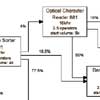
back to project page
Initial Prototype: Description
|
The second-generation prototype of this system has been constructed by extending the Tower, a modular computational system built by our research group at the MIT Media Lab. This page provides some information about how the Crickets and other devices were used to prototype a tabletop modeling toolkit in collaboration with the postal service. It also addresses the weaknesses of the Cricket system for this project. |
|
Images of Prototype
|
|||||||
|
View of the model
|
|||||||
|
Demonstration at USPS
|
|||||||
 |
|||||||
| Revised USPS Mailflow diagram |
|||||||
| More information... | |||||||
|
|||||||
Description
Our second-generation prototype of the Tabletop Process Modeling Toolkit has continued to build on a model of how pre-barcoded mail flows through the Boston South Station USPS mail processing facility. The current prototype was constructed using the Tower modular computation system developed by our research group at the MIT Media Lab, but is otherwise quite similar to the initial prototype. These Towers are connected together to form a tabletop network, in which each node represents a mail processing operation. These towers each have a colored light and a LCD display in order to display both detailed information about the operation's state and visual cues about the simulation as a whole. The simulation is controlled by a laptop computer, which acts as the input by delivering mail to the first processing stage. The Towers then send messages to each other to indicate when mail is being transferred between operations to simulate the operation of the plant, as the laptop continues to inject more mail as it arrives. When all of the mail has been processed, the number of work hours, total mail processed, and start and stop times for each machine may be obtained in a table on the laptop computer.
Tower Technology
The Tower is a small modular computer system, consisting of a computational Foundation and layers which provide additional functionality, such as displays, sensors, motor controllers, and so forth. For this project we developed both a new, more powerful Foundation based on the Rabbit Semiconductor RCM2300 processor module and a new layer that uses serial ports and cables to communicate with other Towers in the simulation.
Each Foundation runs a compact interpreter for the Logo language, which enables novices to quickly write programs to control the capabilities of the Foundation and attached layers. These Logo programs, written on a desktop computer, are downloaded to the foundation via a serial cable. We have developed Logo libraries to handle packet communication and routing between Towers in the tabletop network, providing a robust communication infrastructure upon which users can rapidly build their simulations.
Our growing collection of Tower layers enables us to easily add a variety of capabilities to these tabletop models. We use the sensor layer to add buttons, sliders, and dials to control the simulation's parameters. LCD display layers and tri-color LED boards allow us to display relevant information about the state of the simulation on each Tower, providing both detailed information and important visual cues about the simulation as a whole.